Scarsdale Bowl Dinner Rescheduled for Thursday, September 24th
- Details
- Written by: Joanne Wallenstein
- Hits: 1694
 (This letter was sent to us by the Scarsdale Bowl Committee)
(This letter was sent to us by the Scarsdale Bowl Committee)
Dear Scarsdale Community: Based on the recent developments with the Coronavirus and the recommendation by the Department of Health to avoid large gatherings, The Scarsdale Foundation has rescheduled the Scarsdale Foundation Bowl Dinner to Thursday, September 24th.
We look forward to honoring BK Munguia and Jon Mark together as we celebrate them and all Scarsdale volunteers who make Scarsdale Shine On.
We appreciate your understanding and support during these unusual times. All sponsorships, table hosts, and donations will remain pertinent and all purchased tickets will be transferred and honored on our new date.
Please continue to honor your friends and neighbors on the new Scarsdale Foundation Honor Roll scarsdalefoundation.org/honor-a-scarsdale-volunteer-2020/ and celebrate volunteerism.
If you have any questions, please contact us at ScarBowl@gmail.com. More information is also available on the Scarsdale Foundation website.
The Scarsdale Foundation supports local families who need financial assistance for college and celebrates volunteerism that helps Scarsdale shine.
Partner Sponsors: Advantage Testing, House of Flowers, Advocate Brokerage
Letter from Michelle Sterling: Support the Non-Partisan Slate of Arest, Crandall and Whitestone (Row B) on March 18
- Details
- Written by: Joanne Wallenstein
- Hits: 2283
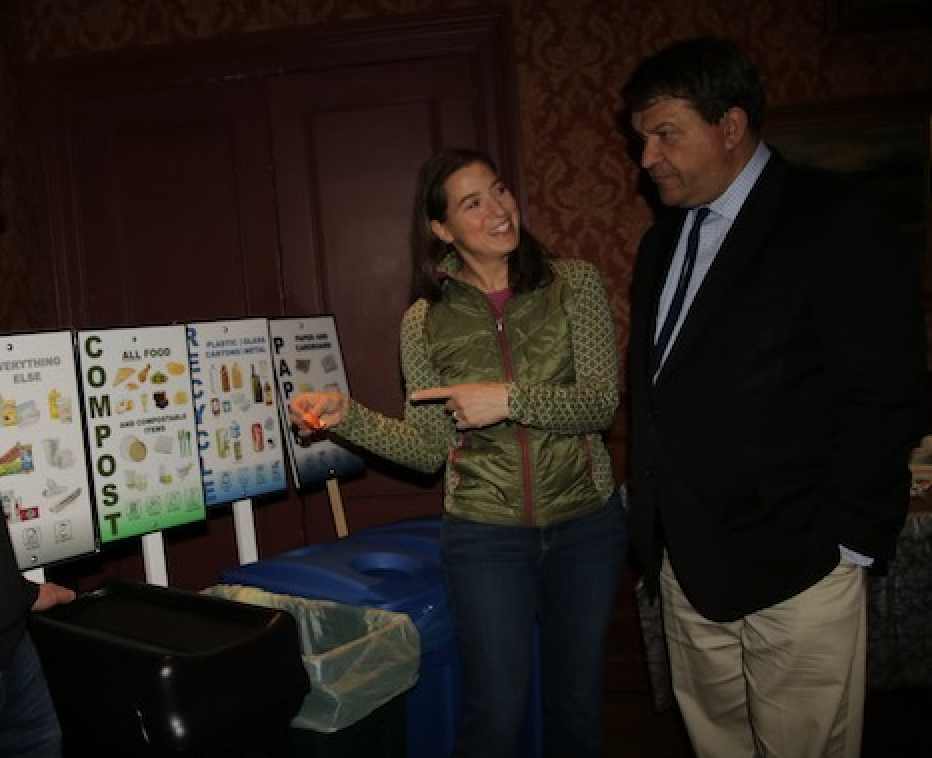 Michelle Sterling with County Executive George LatimerEach year the Citizens’ Nominating Committee (CNC), a group of volunteer citizens elected by residents, thoroughly vets candidates who apply to serve on our Village Board of Trustees. I’m proud to have served on the CNC this year. It’s a non-partisan system - which means that we don’t look at their political affiliation and they don’t run on a specific agenda. What we look at are their qualities as citizens and people in order to determine which of the candidates will come into office with an open mind, and with no personal agenda, so that they can do what they believe is best for our community as a whole. As I look around at the partisan politics surrounding us at every level of government, I am extremely glad that we have a non-partisan system here in Scarsdale.
Michelle Sterling with County Executive George LatimerEach year the Citizens’ Nominating Committee (CNC), a group of volunteer citizens elected by residents, thoroughly vets candidates who apply to serve on our Village Board of Trustees. I’m proud to have served on the CNC this year. It’s a non-partisan system - which means that we don’t look at their political affiliation and they don’t run on a specific agenda. What we look at are their qualities as citizens and people in order to determine which of the candidates will come into office with an open mind, and with no personal agenda, so that they can do what they believe is best for our community as a whole. As I look around at the partisan politics surrounding us at every level of government, I am extremely glad that we have a non-partisan system here in Scarsdale.
This year, once again, the nonpartisan system is being challenged by those who claim that they represent the interests of our town but have time and again shown us that their claims are little more than words and uninformed slogans. For example, they don’t attend important budget meetings and working sessions, which are all open to the public and is where much of the Village’s unglamorous hard work gets done. Members of their slate sue the Village rather than try to work collaboratively through concerns. And they attack and insult many volunteer residents simply because they disagree with their positions or just don’t like them. These are not the qualities of people who should be considered to lead our community.
This year the CNC has proposed two excellent candidates who have completed two-year terms and are eligible for one more term: Justin Arest and Lena Crandall. I have had the pleasure of working with both of these trustees on several sustainability initiatives such as the implementation of our Scarsdale Food Scrap Recycling Program, our LED streetlight conversion and our ongoing project of working to ensure that our Village properties are maintained organically and without toxic chemicals. Working with Trustees Crandall and Arest, I can say that they are both intelligent, hard-working and thoughtful decision-makers. They always listen, consider the facts, and involve our Village volunteers in order to make the best decisions and get to the best results for our community.
On the slate to replace Trustee Veron who is finishing her final term as trustee is Randy Whitehouse, who I believe will contribute to the Board with his new perspectives, communications skills and past Scarsdale volunteer experience.
I’m grateful that these three highly qualified individuals have volunteered to serve our community.
Please Vote for Row B Arest, Crandall, and Whitehouse on Wednesday, March 18 at the Scarsdale Congregational Church.
Michelle Sterling
Brayton Road
Six Candidates for Village Trustee Exchange Views at LWVS Forum
- Details
- Written by: Joanne Wallenstein
- Hits: 2812
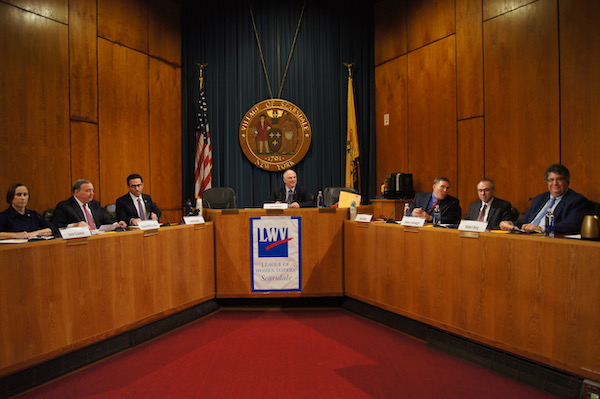 The community had the chance to hear from all six candidates running for Village trustee, at a candidates’ forum held in Rutherford Hall on March 5th, and hosted by the League of Women Voters of Scarsdale (LWVS).
The community had the chance to hear from all six candidates running for Village trustee, at a candidates’ forum held in Rutherford Hall on March 5th, and hosted by the League of Women Voters of Scarsdale (LWVS).
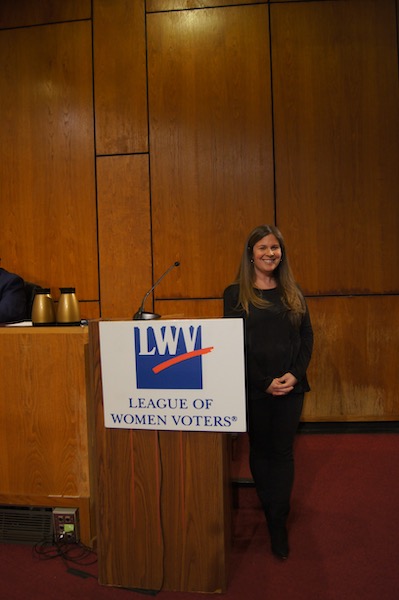 Leah Dembitzer, President of the League of Women Voters of ScarsdaleThe forum was moderated by John Hessel, a non-resident retained by the LWSV, who posed questions to Justin Arest, Lena Crandall and Randy Whitestone from the Scarsdale Citizens’ Non-Partisan Party and Robert Berg, Sean Cohen and Bob Selvaggio from the Voters’ Choice Party.
Leah Dembitzer, President of the League of Women Voters of ScarsdaleThe forum was moderated by John Hessel, a non-resident retained by the LWSV, who posed questions to Justin Arest, Lena Crandall and Randy Whitestone from the Scarsdale Citizens’ Non-Partisan Party and Robert Berg, Sean Cohen and Bob Selvaggio from the Voters’ Choice Party.
They are all running to fill three Village Trustee positions, each having a two-year term. Justin Arest and Lena Crandall are each currently completing their first term as Village Trustee. In a new twist on rules for similar LWSV events in the past, each candidate was given two comment cards that they could use to offer an additional comment or rebuttal. Each candidate was given the chance to make an opening statement in order of their seating, determined by a lottery.
Scarsdale Non-Partisan Party
Lena Crandall, who is running for her second term, explained that she has “Transitioned from community activist working on single issues to a public servant.” She said, “I have broadened what I work on because I represent all the residents.”
She stressed that the Board of Trustees “Works together try to find the best solutions,” and said, “This election is about being civil.”
Randy Whitestone, running for his first term, detailed why he wants to be a trustee. He said, “as a former journalist I am curious – I know how to ask questions and listen. …I want to give back… I want to roll up my sleeves…I love Scarsdale. He said, “my grandparents moved here in 1928 – and I have lived here for 25 years with my wife Lisa.”
Justin Arest, also running for a second term, vowed to “continue to serve with integrity, open mindedness and respect,” and… to “be a fiduciary, to oversee how the village is run on your behalf." He said, “Lively debate produces better outcomes” and, “maintaining civility through discourse matters.” “We are so fortunate to leave here, but we have our challenges like aging infrastructure, unfair changes to federal tax codes and unfunded mandates.” He said, “We are ready to deal with the challenges head on.”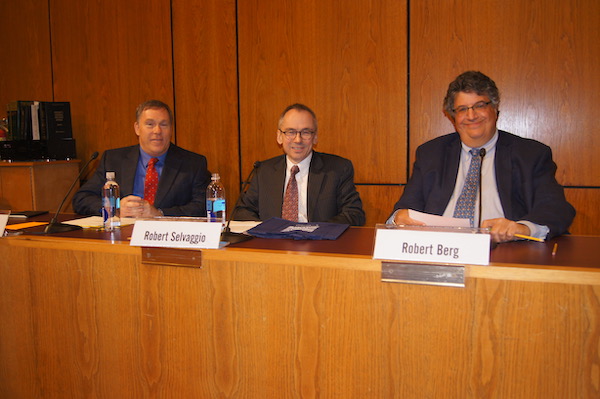 Sean Cohen, Bob Selvaggio and Bob Berg from the Voters Choice Party
Sean Cohen, Bob Selvaggio and Bob Berg from the Voters Choice Party
Voters’ Choice Party
Sean Cohen said, “Questioning voices are good.” Posing the question that many had on their minds, he said, “Why risk changing the system? He answered it saying, “Scarsdale is something we all want to keep. Decisions threaten that. Outside questioning voices will bring fresh perspective and make our system healthier.”
Bob Selvaggio said, “I believe that transparency and unfettered information flow enforces discipline. I have decades of expertise in economics, analytics and risk management.” Referring to the proposals for Freightway development he said, “I will work to require publicly disclosed cost benefit analyses. The criteria (for development) should include positive fiscal impact and no added burden on our trains and our schools. The VCP is a party that cares. We believe in solving problems…. I want to make Scarsdale more affordable to our residents.”
Robert Berg, said he is an 18-year resident of Scarsdale who has “stayed despite high taxes … because Scarsdale is a wonderful place. He said, “I have been an active volunteer for years for SNAP, the Scarsdale Forum, the town Board of Assessment Review where he served one year as chair. Discussing the need for his party to challenge the SCNP he said, “The village board has been run by a single party for 109 years. We need greater transparency and accountability.”
Questions from the League – One candidate from each party asked the following questions --
1) What do you consider the three most pressing issues and what do you suggest be done?
Whitestone responded, “Deciding what to do about Freightway – repair it or develop the site. Get more data, traffic, safety, impact on schools.” He went on, “Getting our downtown to be more vital. There’s more that can be done. Scarsdale Improvement Corporation is going to have to be part of the solution.” And, “Sustainability: Climate smart community and food scrapping are good. We should focus on making Scarsdale more walkable and think about how people and bicycles interact with vehicles.”
Sean Cohen said, “The #1 issue is Freightway. We have spent $300,000. We need to repair it and move on – and then look at the land next to it. We should engage residents further rather than retain consultants. About downtown, he said, we need to “engage with the landlord of downtown properties to encourage the landlord.”
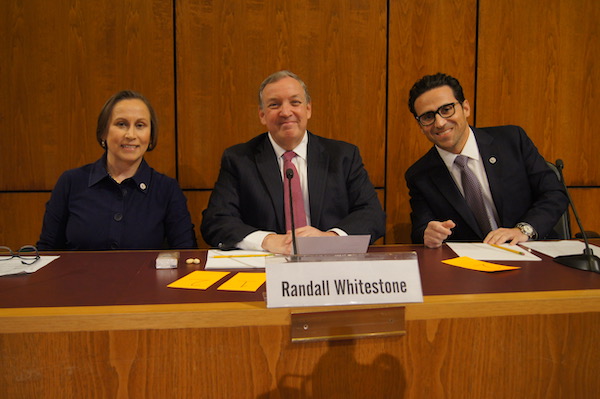 Lena Crandall, Randy Whitestone and Justin Arest from the Scarsdale Citizens Non-Partisan Party
Lena Crandall, Randy Whitestone and Justin Arest from the Scarsdale Citizens Non-Partisan Party
2) How do you balance taxes with the kind or services residents expect?
Crandall said, “We are all feeling the impact of the SALT law.” Discussing services she said, “Police respond within a minute. That keeps me in Scarsdale. We have an excellent fire department and refuse is picked-up in our driveway. We have food scrap pick up and a hard-working staff to maintain services. We have kept our eye on the bottom line while providing value.”
Selvaggio responded to the same question, saying, “I like that the six of us are non-partisan. We should consider shared services – and work with other communities to be more efficient. We need to diversify and broaden our tax base. Let’s look at commercial development that provides positive fiscal impact.”
3) Some experts believe that local response is critical to address disasters.
Arest said, “As a local government we need to hope for the best and plan to the worst. We depend on the County Health Department – but we need to make sure our first responders are prepared and we need continuity of services in case our staff gets sick. In addition, we need communication and coordination and we need to convey facts.”
Berg agreed that “We do have very qualified staff and we should call on them to help… we have to prevent panic and take preventative measures like taking down trees that pose dangers in storms.”
Cohen concurred saying, “We have tremendous talent in our community and there are many issues where we can tap into that talent. For example: We have many doctors – what is best, how do we plan?”
Crandall added, “We have an engaged community. What is unique about Scarsdale is that any resident is welcome to participate in our democracy – by coming to the podium and by volunteering for boards and councils. We need you. I am first generation American. I know what happens when governments do what they are not supposed to do.”
4) What should be the process for selecting people to serve on Village Boards and Councils.
Selvaggio said “they could provide advisory service but they are not elected or governing. These people should service those who are making decisions. We have seen egregious examples of nepotism and the decision not to re-appoint qualified volunteers. We have seen misbehavior. And we have to be very careful when it comes to ethics. We want to be very careful NOT to insult them by punishing some people who have been valuable volunteers.”
Whitestone added, “In my experience there is always an opportunity if you want to serve. There are 160 people participating. The Scarsdale Forum does a great job of doing studies. There are many opportunities to serve but I think there is a shortage of qualified people coming forward. There is such a busy life that we lead. The question is How do we communicate to potential volunteers that we do want their perspectives and their thoughts? Frankly, I hope we can reach more.”
5) How can we enhance property values in Scarsdale:
Cohen said, “As taxes go up they depress property values. We can watch mission creep. This village does things that add to our tax basis. We have to be disciplined and not have taxes go up.”
Arest said, “On one hand it’s watching the budget to ensure that our infrastructure needs are addressed. Referring to the 2021 budget he said, “We’re coming in under 2% [tax cap].” He added, “We are going to do a survey to find out what services residents want and improve them as they request.”
Selvaggio said, “We need to consider the most vulnerable amongst us: those who earn less than $250,000/year. They got whacked on their home value. We are going to do smart commercial development to lower taxes on single family residents.”
Taking issue with Selvaggio, Arest parried, “It is so insulting for someone who has not participated in one budget meeting to act as if we are not concerned with lowering taxes. Soundbites do not govern. Ideas can be cheap. It means rolling up your sleeves and getting things done. We are open to your ideas.”
Berg defended his attendance at meetings saying, “I have attended a number of budget meetings. I served on the BAR the last 8 years. Property values are dropping. Scarsdale home values have dropped 25-40%, especially at the high end. The village has its head in the sand. We are getting crushed on our concierge tax level. We have to stop using consultants! You spent over $300,000 on Freightway to date.”
6) What is the biggest misperception about you and what motto best describes you?
Berg got a laugh when he said, “One of the biggest misperceptions is that I am mean, nasty and I don’t get along with people. I was the President of the Scarsdale Forum and have volunteered for years. People who work with me find that I am a pleasant fellow…” “I have to speak harshly at the board meetings because I have a 5-minute time limit. I am not mean.”
Crandall also got laughs when she said, “The misperception about me is that I only care about trees and sustainability. I also care about economic sustainability – being efficient – with good goals in mind. I believe the analysis of Freightway will show us what makes sense.” Crandall went on to mention that her personal motto is like that of the school district, “non sibi, not for self alone.”
The moderator then read questions from the audience.
Do you have any conflicts of interest as trustee and if so how would you handle those if elected?
Arest responded firmly saying, “No I do not. The state is very clear on this – mostly it is about an economic or material benefit that one might receive. We have to sign a form every year to disclose any potential conflicts. We made it part of the village code.”
Selvaggio said that he “would have to recuse himself if the Village continues to pursue their lawsuit against Robert Berg for the placement of signs in the Village right of way.” He was referring to a lawsuit actually brought by Robert Berg against the Village, who objected in 2018 when police removed his political signs from the 13-foot Village right of way on front lawns. The suit is pending. Selvaggio said, “I would recuse myself from that vote, I guess.”
(NOTE: Bob Selvaggio did not mention that he is one of 152 named litigants on the Article 78 against the Village, seeking to overturn the second reval, commonly referred to as the Ryan Reval, in favor of the first, the Tyler Reval. The suit was dismissed by the trial court, an appeal is pending.)
Turning to the subject of the overexpansion of homes and the protection of the “Village in a Park,”
Whitestone said, “We have seen every inch of property taken over with development. Yet it is difficult to limit property rights. There has been lots of talk about expanding the tax base. It is a tough one. I regret it but it’s probably an economic reality.”
Berg said, “I enjoy the Village in the Park but we have many properties that are not historic. Taking these down is good for our tax base. But there are loopholes in the building code that should be closed that allow for overbuilding. These bonuses should be tightened. I think our historic preservation law needs to be tightened.”
And what about road repair?
Crandall said “I believe it is over 8-miles of road work this year. We have spent thousands to repair the roads. We are using money from Con Edison to fix the roads as well. Surplus funds at the end of the year are also used for additional road repair. If you see a problem, be a part of the solution. Call Village Hall to report potholes.”
Cohen said, “We need to fix the small cracks so they don’t become big cracks along the way.”
Discussing environmental issues....
Berg raised the issue of raw sewage backing up into people’s basements on Barry Road. He charged, “The Village has done nothing. What is the emergency response? They have not addressed the infrastructure – but at the same time built a beautiful library.”
Arest took issue with Berg, saying “If you don’t go to the meetings, you don’t know what’s happened. Let’s talk about what we are doing. Inflow and infiltration (INI) is due to illegal connection and we are doing smoke tests. We are working on solutions. We are being more proactive. This involves multiple municipalities, so we are working with them – like New Rochelle, who is on higher ground. We are working with the County, with Ben Boykin, to clean out the county trunk line. A Village Engineer is dedicated to working on the problem. What is happening is unacceptable and we are taking it seriously. For sustainability, we just became a Climate Smart community and we are leaders.”
Berg used his card to complain that “the issue has been a problem for two decades and has been raised repeatedly. And yet the Village has done nothing. Really nothing. The Village has enormous liability for raw sewerage bubbling out of our streets. The village has no plan.”
Next was a question about improving transparency and openness in Village Government.
Selvaggio responded, “We think about a scorecard. One of the key elements would be a count of how many FOIL requests have been filed. I want our residents to have free access to information. When Bob went to find out how much was spent on the consultants he had to file a FOIL request. Let’s end this tradition of requiring FOIL requests to find out where our taxes are going.”
Crandall defended the village saying, “We have a committee on communications. We have a weekly email – Scarsdale Official. Mr. Berg – you have showed up here and there but you did not attend the many hours of budget hearings. There is so much detail. The minutes are online – they are informative.”
Cohen said he found Rutherford Hall to be intimidating and proposed a redesign…. (This is a capital improvement that has been proposed in the past and has been deferred in order to address more pressing infrastructure issues.) He said, “When you come to this meeting it’s like appearing before the Supreme Court. I would totally redo this room. Not everyone can read all these reports. Sometimes you should be able to ask a simple question and get a simple answer.”
About Freightway, Cohen said, “The last meeting about Freightway was well attended thanks to the Voters’ Choice Party. I believe in taking a stand and leadership. We need to fix the parking garage. Maybe in the future we will not have as many cars. The empty lot next door to Freightway can be developed into restaurants and stores.”
Whitestone revealed that he is an amateur historian and discovered that when the trustees voted to build the garage in 1971 for $1.8 million it was very controversial. He said, “I have an open mind. We have to gather data about the school population, traffic flows and how it might connect to the downtown. I am not dedicated to one side or another. It is a village asset and we have to find a solution that is good for the long term.”
In closing statements, in order of their seating, determined by a lottery:
Berg said, “I grew up in a cookie cutter community on the South Shore of Long Island. There was no opportunity for community involvement. I got hooked on volunteerism early and it is addictive. I like to help our residents. I joined the BAR to help – and we serve as a user-friendly board and help residents to get a tax reduction.”
Selvaggio said, “I would like to address some misperceptions. We are not looking to be disruptive -- and we are collegial. We want to provide a fresh perspective. We want to promote competition and good analysis. We want to stay here and stay friendly- and be neighbors and friends.”
Cohen thanked the League and reiterated, “There is nothing wrong with taking a stand. If we keep standing behind committees and endless studies, where are we? On sustainability and these big houses getting built, it was the first reval that led to these big houses getting built, and also it was the first reval that ejected a lot of elder members of our community out. …We have to think about the consequences, which are foreseeable.”
Arest said, “It been an honor to serve you and awesome volunteering with so many. Volunteering does lead to more volunteering.” “I am proud to be nominated and I do believe in the system and the reference vetting that goes on is so important. The fearmongering on Freightway is disappointing – that we aren’t worrying about the community. We have tried to be as open as we can. We look forward to sharing all the information about Freightway.”
Whitestone concluded by saying “I think there is so much value to citizen engagement in Scarsdale. I will work with the other trustees, weigh options and come to consensus.”
Crandall said “I moved here 28 years ago and became involved about 18 years ago. I understand what the VCP candidates are saying. It takes a while to figure out how this community comes together. But after hours of participation, once you figure it out, it’s incredible.”
As candidates answered queries and the evening wore on it was evident that the Village is generally well run, essential services are being provided and the next budget is expected to come in below the tax cap. The Non-Partisan Party emphasized their diligence and time spent coming to consensus on the best solutions for the Village while the Voter’s Choice Party emphasized the need for choice. The challengers each highlighted what is wrong with both Scarsdale Village and the traditional non-partisan system -- while at the same time presenting themselves as people who work within the system and can work well with others. It’s a conundrum.
Though all the candidate’s strove to emphasize their differences, it was apparent that with limited funds and the need to provide essential services, there is little play in the Village budget to effect radical change. However, both parties emphasized the value of citizen engagement in the process to forge the best solutions.
The forum itself was an excellent example of how Scarsdale’s most engaged can work for the betterment of Scarsdale. But make your own decision about the candidates. A video of the entire event is available on the LWVS website:
Vote in the Village election on Wednesday March 18 at Scarsdale Congregational Church at One Heathcote Road from 6 am to 9 pm.
Commenting on our coverage above, candidate Robert Selvaggio said the following:
Thank you for your comprehensive coverage of the League of Women Voters debate. Bob, Sean and I enjoyed the event and I think it gave all six of us the opportunity to show that we are collegial and view one another as neighbors and competing candidates -- not as enemies.
I am confused (but not dismayed) about your inclusion of my participation in the Article 78 lawsuit challenging the validity of the Ryan revaluation, as that was not raised in the session. I think, however, it’s appropriate and important to discuss this fully since you raised the issue. I also think you mischaracterized and trivialized somewhat my response about the Federal Court case stemming from the confiscation of our homeowners’ lawn signs and I’d like to add perspective that can also be viewed from the online recording of the event.
First, in my comment about recusing myself in matters pertaining to the lawsuit filed by Bob Berg, I made it very clear that this was a First Amendment case – and that defending the Bill of Rights is important to all citizens. This is not simply a matter of “placement of signs in the Village right of way”, but since the lawsuit has been filed, I confess to having been happy to see our residents remaining free to express themselves with lawn signs such as “Hate as no Home Here”, “Socialism has No Home Here”, “Scarsdale Raiders”, and “Berg-Cohen-Selvaggio for Village Trustee”. It is a fact documented in the court filings that many homeowners have had signs removed from our lawns by the Scarsdale Police Department over the past several years. We may not each of us personally agree with viewpoints expressed on these signs, but I think we all agree that the freedom to express those views is sacrosanct to Americans. We owe a debt of gratitude to Mr. Berg for defending that freedom in court at his own expense.
Second, my participation in the Article 78 proceedings including a pro bono expert report stems from my professional opinion as a fully credentialed economist and a financial risk manager that the model employed by Mr. Ryan was not properly documented and validated (my understanding is that model documentation has still not been supplied to us, and we have no way of knowing if it ever existed). My view is that there was a very high probability that many homeowners were systematically over-assessed by that model and suffered economic loss as a result.
I continue to believe that the process and results of the “Ryan reval” were sufficiently flawed that it should have been discarded and that the Village Board failed in its fiduciary duty to ensure that the model employed had been fully and properly documented and validated before its results were imposed on Scarsdale residents. Unvetted models should never be used to inform important decisions.
I view the notorious “Ryan reval” as water under the bridge and what is hopefully a lesson learned. It is important that we do not repeat the mistakes of that episode and that we instead begin embracing data-driven decision making and sound modeling practices as we go forward with Village projects such as Freightway and other nonresidential commercial development, sewer repair, and long-range fiscal planning.
Best regards,
Bob
Save Your Old Cans of Paint: NYS Passes Paint Recycling Law
- Details
- Written by: Joanne Wallenstein
- Hits: 2276
 New York State has just passed a paint stewardship law that gives New Yorkers the ability to have their paint recycled instead of putting it in the trash.
New York State has just passed a paint stewardship law that gives New Yorkers the ability to have their paint recycled instead of putting it in the trash.
Under the new law residents will be able to bring their cans of paint --as well as varnishes, shellacs, primers, and sealers --to designated drop-off locations in our local area. The paint will then be picked up by a company that specializes in paint recycling, and will be reused, recycled or disposed of in an environmentally friendly way.
The statewide paint stewardship program will be implemented by early 2021. Residents will be informed as to when the program is operational and where our closest drop-off site will be. So please save your old cans of paint until then! If you have questions please email Michelle Sterling of the Scarsdale Conservation Advisory Council at michellesterling1@gmail.com.
LWVS To Host Candidate Forum For Contested Village Election
- Details
- Written by: Joanne Wallenstein
- Hits: 3999
 The League of Women Voters encourages informed and active participation of citizens in local government and the election process. This year, the Scarsdale Village election for Trustee is contested. There are six candidates vying for three positions as Village Trustee. The LWVS is hosting a Candidate Forum on Thursday, March 5, 2020 from 7:30 pm - 9:30 pm in Rutherford Hall at Scarsdale Village Hall. We encourage all Scarsdale citizens to come hear from the candidates and to provide questions to be asked of them. For those who cannot attend, the event will be recorded for playback and made available for public viewing.
The League of Women Voters encourages informed and active participation of citizens in local government and the election process. This year, the Scarsdale Village election for Trustee is contested. There are six candidates vying for three positions as Village Trustee. The LWVS is hosting a Candidate Forum on Thursday, March 5, 2020 from 7:30 pm - 9:30 pm in Rutherford Hall at Scarsdale Village Hall. We encourage all Scarsdale citizens to come hear from the candidates and to provide questions to be asked of them. For those who cannot attend, the event will be recorded for playback and made available for public viewing.
Each Trustee position in Scarsdale Village is a two-year term. The Citizens Nominating Committee (CNC) has put forth its slate of candidates for each slot: Justin Arest and Lena Crandall, who are seeking second terms as Trustee, and Randall Whitestone. Running as a candidate for Village Trustee under the Voter’s Choice Party is Robert Berg, Robert Selvaggio and Sean Cohen. The Village Election is Wednesday, March 18th. All Election Districts will be voting at the Scarsdale Congregational Church, 1 Heathcote Road, Scarsdale, in Dyckman Hall. Hours of the election are 6 a.m. to 9 p.m. As Village Clerk Donna Conkling has explained, the top three vote recipients in the election will each garner a spot as Village Trustee.
If you are not a registered voter but want to vote in the Village Election on Wednesday, March 18, 2020, the last day to register with the Westchester County Board of Elections is Friday, March 6th. You may pick up a mail-in registration form at Village Hall, visit the Westchester County Board of Elections website here or you may go directly to the Westchester County Board of Elections, 25 Quarropas Street, White Plains. Please note that the voter registration form indicates the form should be returned to Westchester County at least 25 days prior to the election; however, in the case of a Village Election, the form should be returned at least 10 days prior to the election. In order to register to vote, you must:
● Be a U.S. Citizen
● Be 18 years of age by the date of the election in which you want to vote
● Live at your present address at least 30 days before an election
● Not be in prison or on parole for a felony conviction
● Not claim the right to vote elsewhere
For registered voters who will be out of Westchester County on Village Election Day, an absentee ballot can be obtained by filling out an application form at Village Hall or by requesting one by phone or mail, or downloading directly from the Village website here.
Tuesday, March 10, 2020 is the last day for the Village Clerk to receive an application for an absentee ballot which is to be mailed to a qualified voter; however, applications made in person can be accepted until Monday, March 16, 2020.
For more information, call the Village Clerk’s office at (914) 722-1175 or visit the League website at www.LWVS.org.










